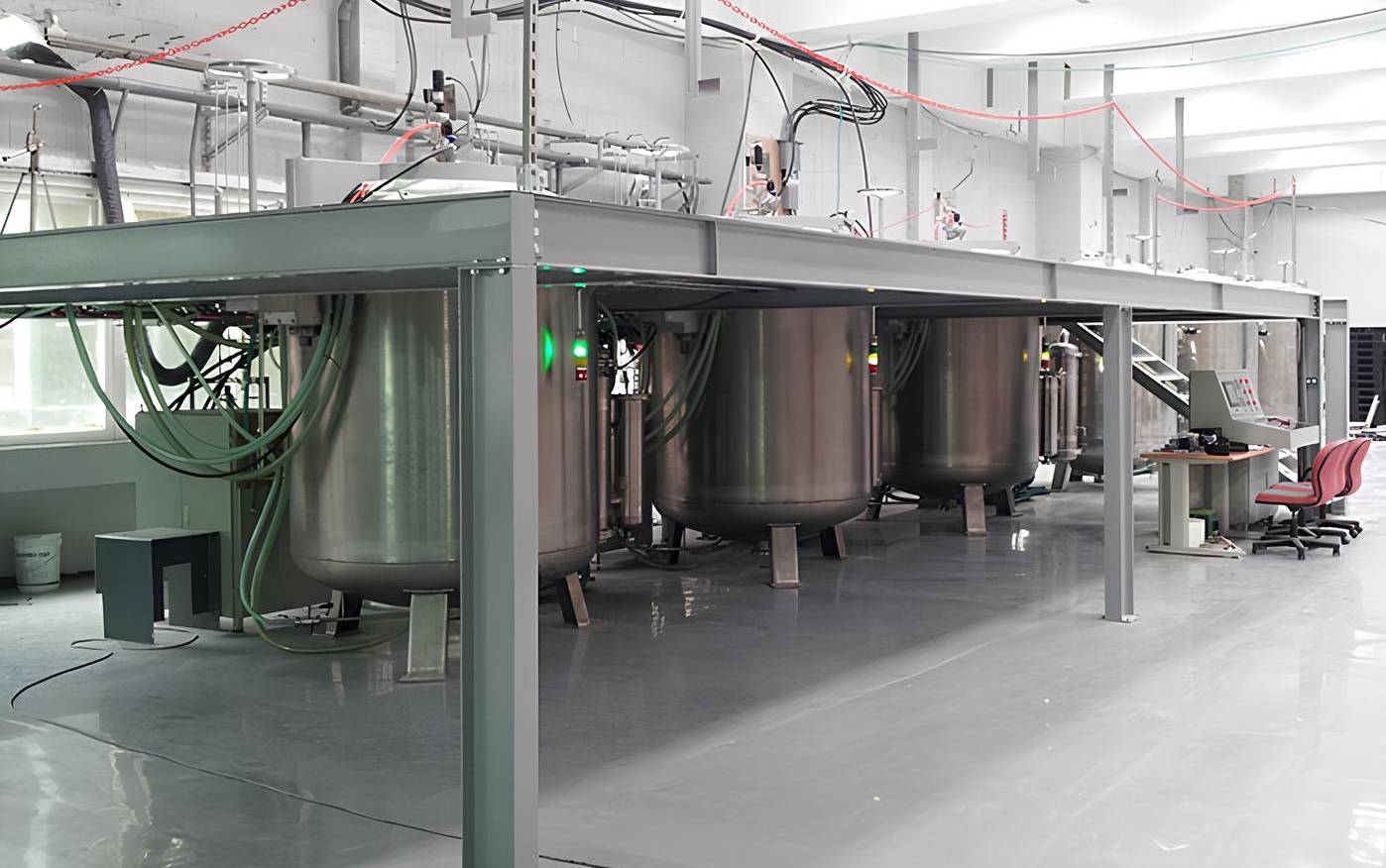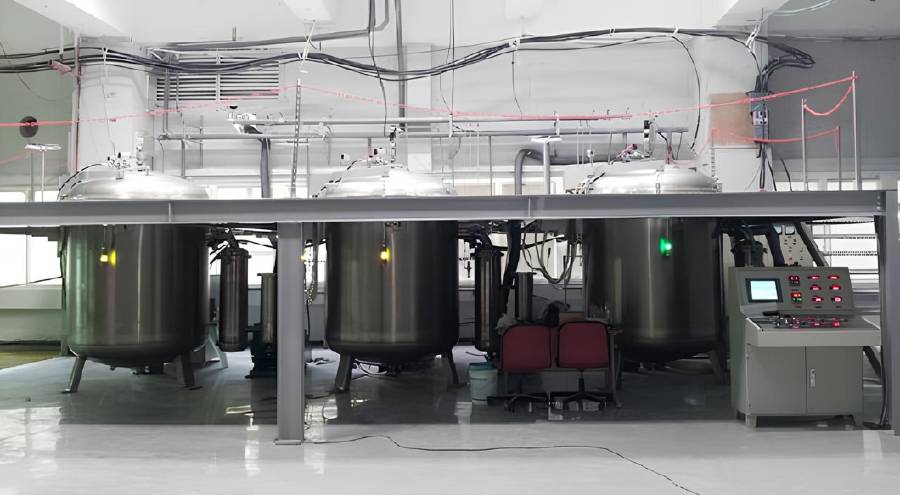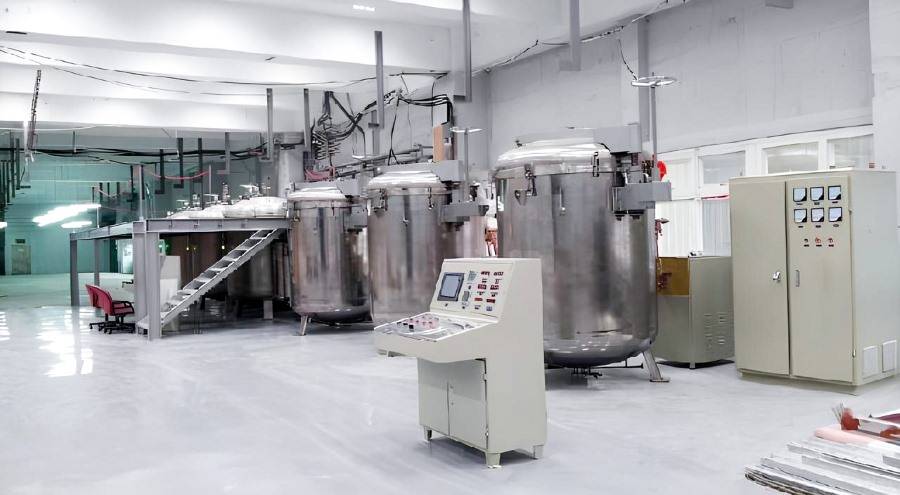
Graphitization furnace
Graphite Vacuum Furnace Negative Material Graphitization Furnace
Item Number : GF-04
Price varies based on specs and customizations
- Volume (L)
- 125 / 196 / 282 / 550 / 1000 / 1500
- Effective heating area (mm)
- Φ400×1000 / Φ500×1000 / Φ600×1000 / Φ700×1400 / Φ900×1600 / Φ1000×2000
- Power (KW)
- 150 / 250 / 350 / 550 / 700 / 1000
- Frequency (HZ)
- 1500 / 1000
Shipping:
Contact us to get shipping details Enjoy On-time Dispatch Guarantee.
Why Choose Us
Reliable PartnerEasy ordering process, quality products, and dedicated support for your business success.
Introduction
A graphitization furnace is a specialized piece of equipment used in the production of battery negative electrode materials. It utilizes medium frequency induction heating for rapid temperature increase and high efficiency. The unique furnace design ensures excellent temperature uniformity throughout the furnace body. Double-layer alumina brick insulation offers exceptional heat insulation and fire resistance, minimizing heat loss and enhancing equipment stability. The system allows for continuous operation through multiple power supplies and electric furnaces, with configurable heating and cooling cycles. Advanced features include a digital flow monitoring system for water flow monitoring and protection, high-performance medium frequency contactor, and a comprehensive PLC water, electricity, gas automatic control and protection system.



Applications
Negative material graphitization furnaces are used in a variety of applications, including:
- Production of battery negative electrode materials
- Graphitization of carbon felt
- Graphitization of carbon fiber
- Graphitization of petroleum coke
- Graphitization of coal tar pitch
Features
-
Enhanced Temperature Uniformity: Utilizes medium frequency induction heating for rapid temperature rise and high efficiency. The unique furnace design significantly improves temperature uniformity throughout the furnace body, ensuring consistent graphitization results.
-
Energy-Efficient and Stable Operation: Employs double-layer alumina brick insulation to prevent short circuits between carbon felt and coil. This design ensures good heat insulation and fire resistance, minimizing heat loss and promoting equipment stability.
-
Continuous Operation Capability: Multiple electric furnaces can be powered by a single power supply, allowing for continuous operation. The furnaces can be individually heated up and cooled down based on the sintering process time, maximizing productivity.
-
Comprehensive Control and Protection System: Features a digital flow monitoring system with water flow monitoring and protection in the power cabinet. The furnace conversion utilizes high-performance medium frequency contactors. The PLC-based water, electricity, and gas automatic control and protection system ensures safe and reliable operation.
Principle
The negative material graphitization furnace utilizes medium frequency induction heating to rapidly raise the temperature of carbonaceous materials, inducing their conversion into graphite. This process takes place in an inert atmosphere to prevent oxidation and maintain the integrity of the graphite structure. The furnace's unique design ensures uniform temperature distribution throughout the chamber, resulting in consistent graphitization of the material.
Advantages
- High temperature uniformity: The unique furnace design ensures consistent temperature distribution throughout the furnace chamber, resulting in uniform graphitization of the materials.
- Energy efficiency: Double-layer alumina brick insulation minimizes heat loss, reducing energy consumption and operating costs.
- High stability: The furnace's robust construction and double-layer insulation provide excellent stability, preventing short circuits and ensuring reliable operation.
- Continuous operation: Multiple furnaces can be connected to a single power supply, allowing for continuous operation with staggered heating and cooling cycles.
- Precise control: Digital flow monitoring and PLC-based control system enable precise regulation of water, electricity, and gas supply, ensuring optimal process conditions.
- High efficiency: Medium frequency induction heating promotes rapid temperature rise, significantly increasing process efficiency.
- Versatile applications: Suitable for a wide range of high-temperature treatments and graphitization processes, including battery negative electrode materials production.
Technical parameters and model specifications
Maximum operating temperature: 3100℃
Commonly used temperature: 2800℃
Working atmosphere in the furnace: argon, nitrogen
Temperature uniformity: ≤±25℃
Temperature measurement: infrared optical temperature measurement (1000-3200C);
Temperature measurement accuracy: 0.2~0.75%
Temperature control: program control and manual control
Temperature control accuracy: ±1℃
| Product model specifications | GF-04-Ф40×100 | GF-04-Ф50×100 | GF-04-Ф60×100 | GF-04-Ф70×140 | GF-04-Ф90×160 | GF-04-100×200 |
|---|---|---|---|---|---|---|
| Volume(L) | 125 | 196 | 282 | 550 | 1000 | 1500 |
| Rated temperature(C) | 2800 | 2800 | 2800 | 2800 | 2800 | 2600 |
| Limit temperature(C) | 3100 | 3100 | 3100 | 3100 | 300 | 2800 |
| Effective heating area (mm) | Ф400×1000 | Ф500×1000 | Ф600×1000 | Ф700×1400 | Ф900×1600 | Ф1000×2000 |
| Power(KW) | 150 | 250 | 350 | 550 | 700 | 1000 |
| Frequency(HZ) | 1500 | 1000 | 1000 | 1000 | 1000 | 1000 |
| Temperature control method | Japan Shima Electric Thermostat | |||||
| Heating method | Induction heating | |||||
| Vacuum system | Rotary vane vacuum pump (for high vacuum requirements, Roots vacuum pump and oil diffusion pump are required) | |||||
| Sintering atmosphere | N² Ar and other gases | |||||
| Rated power supply voltage (V) | 380 | |||||
| Rated heating voltage (V) | 750 | |||||
| Vacuum limit (Pa) | 100 (vacuum cold state) | |||||
FAQ
What Is A Graphitization Furnace?
What Is A Graphite Vacuum Furnace Used For?
What Is A Vacuum Furnace Used For?
What Are The Main Types Of Battery Materials?
What Is The Purpose Of A Negative Material Graphitization Furnace?
What Are The Environmental Considerations For Using A Negative Material Graphitization Furnace?
What Are The Main Applications Of Graphitization Furnaces?
What Are The Main Types Of Graphite Vacuum Furnaces?
What Is The Process Of A Vacuum Furnace?
What Are The Applications Of Battery Materials?
What Materials Can Be Processed In A Negative Material Graphitization Furnace?
What Are The Different Types Of Graphitization Furnaces?
How Does A Graphite Vacuum Furnace Work?
What Gas Is Used In A Vacuum Furnace?
How Do Battery Materials Enhance Battery Performance?
How Does A Graphitization Furnace Work?
What Are The Advantages Of Using A Graphite Vacuum Furnace?
What Is The Heating Element Used In A Vacuum Furnace?
What Is The Role Of Polyethylene Separators In Lithium-ion Batteries?
What Are The Advantages Of Using A Graphitization Furnace?
What Temperature Range Can A Graphite Vacuum Furnace Achieve?
Why Are Conductive Carbon Cloths/papers/felts Important In Battery Applications?
What Industries Benefit From Graphite Vacuum Furnaces?
What Are The Advantages Of Using Aluminum-plastic Flexible Packaging Films For Lithium Batteries?
How Does The Lithium Cobaltate Material Contribute To Battery Performance?
What Is The Function Of Battery Internal Resistance Testers?
Why Are Nickel-aluminum Tabs Important In Battery Manufacturing?
4.8
out of
5
The delivery was incredibly fast. I placed the order on Monday and received it on Wednesday. The packaging was secure and the product arrived in perfect condition.
4.9
out of
5
This furnace is a great value for the price. It's well-made and has all the features I need.
4.7
out of
5
The quality of this furnace is excellent. It's made from high-quality materials and is built to last.
4.8
out of
5
I've been using this furnace for several months now and it's still going strong. It's very durable and has held up well to heavy use.
4.9
out of
5
The technological advancement of this furnace is impressive. It's equipped with the latest features and is very user-friendly.
4.7
out of
5
I highly recommend this furnace to anyone in need of a high-quality, durable, and technologically advanced product.
4.8
out of
5
The furnace arrived on time and in perfect condition. It was easy to set up and use.
4.9
out of
5
The furnace has met all of my expectations. It's a great product that I would definitely recommend to others.
4.7
out of
5
I'm very happy with the performance of this furnace. It's a great value for the price.
4.8
out of
5
The furnace is very well-made and has a sturdy construction. I'm confident that it will last for many years to come.
REQUEST A QUOTE
Our professional team will reply to you within one business day. Please feel free to contact us!
Related Products

Graphite Vacuum Furnace Bottom Discharge Graphitization Furnace for Carbon Materials
Bottom-out graphitization furnace for carbon materials, ultra-high temperature furnace up to 3100°C, suitable for graphitization and sintering of carbon rods and carbon blocks. Vertical design, bottom discharging, convenient feeding and discharging, high temperature uniformity, low energy consumption, good stability, hydraulic lifting system, convenient loading and unloading.

Vertical High Temperature Graphite Vacuum Graphitization Furnace
Vertical high temperature graphitization furnace for carbonization and graphitization of carbon materials up to 3100℃.Suitable for shaped graphitization of carbon fiber filaments and other materials sintered in a carbon environment.Applications in metallurgy, electronics, and aerospace for producing high-quality graphite products like electrodes and crucibles.

Graphite Vacuum Furnace IGBT Experimental Graphitization Furnace
IGBT experimental graphitization furnace, a tailored solution for universities and research institutions, with high heating efficiency, user-friendliness, and precise temperature control.

Graphite Vacuum Continuous Graphitization Furnace
High-temperature graphitization furnace is a professional equipment for graphitization treatment of carbon materials. It is a key equipment for the production of high-quality graphite products. It has high temperature, high efficiency and uniform heating. It is suitable for various high-temperature treatments and graphitization treatments. It is widely used in metallurgy, electronics, aerospace, etc. industry.

Large Vertical Graphite Vacuum Graphitization Furnace
A large vertical high-temperature graphitization furnace is a type of industrial furnace used for the graphitization of carbon materials, such as carbon fiber and carbon black. It is a high-temperature furnace that can reach temperatures of up to 3100°C.

Ultra-High Temperature Graphite Vacuum Graphitization Furnace
The ultra-high temperature graphitization furnace utilizes medium frequency induction heating in a vacuum or inert gas environment. The induction coil generates an alternating magnetic field, inducing eddy currents in the graphite crucible, which heats up and radiates heat to the workpiece, bringing it to the desired temperature. This furnace is primarily used for graphitization and sintering of carbon materials, carbon fiber materials, and other composite materials.

Graphite Vacuum Furnace High Thermal Conductivity Film Graphitization Furnace
The high thermal conductivity film graphitization furnace has uniform temperature, low energy consumption and can operate continuously.

Horizontal High Temperature Graphite Vacuum Graphitization Furnace
Horizontal Graphitization Furnace: This type of furnace is designed with the heating elements placed horizontally, allowing for uniform heating of the sample. It's well-suited for graphitizing large or bulky samples that require precise temperature control and uniformity.

Vacuum Arc Induction Melting Furnace
Discover the power of Vacuum Arc Furnace for melting active & refractory metals. High-speed, remarkable degassing effect, and free of contamination. Learn more now!

Vacuum Heat Treat and Molybdenum Wire Sintering Furnace for Vacuum Sintering
A vacuum molybdenum wire sintering furnace is a vertical or bedroom structure, which is suitable for withdrawal, brazing, sintering and degassing of metal materials under high vacuum and high temperature conditions. It is also suitable for dehydroxylation treatment of quartz materials.

Carbon Graphite Boat -Laboratory Tube Furnace with Cover
Covered Carbon Graphite Boat Laboratory Tube Furnaces are specialized vessels or vessels made of graphite material designed to withstand extreme high temperatures and chemically aggressive environments.

Vacuum Hot Press Furnace Heated Vacuum Press Machine Tube Furnace
Reduce forming pressure & shorten sintering time with Vacuum Tube Hot Press Furnace for high-density, fine-grain materials. Ideal for refractory metals.

Vacuum Induction Melting Spinning System Arc Melting Furnace
Develop metastable materials with ease using our Vacuum Melt Spinning System. Ideal for research and experimental work with amorphous and microcrystalline materials. Order now for effective results.

Vacuum Heat Treat and Sintering Furnace with 9MPa Air Pressure
The air pressure sintering furnace is a high-tech equipment commonly used for the sintering of advanced ceramic materials. It combines vacuum sintering and pressure sintering techniques to achieve high-density and high-strength ceramics.

Lab-Scale Vacuum Induction Melting Furnace
Get precise alloy composition with our Vacuum Induction Melting Furnace. Ideal for aerospace, nuclear energy, and electronic industries. Order now for effective smelting and casting of metals and alloys.

Dental Porcelain Zirconia Sintering Ceramic Vacuum Press Furnace
Get precise dental results with Dental Vacuum Press Furnace. Automatic temperature calibration, low noise tray, and touch screen operation. Order now!

Vacuum Sealed Continuous Working Rotary Tube Furnace Rotating Tube Furnace
Experience efficient material processing with our vacuum-sealed rotary tube furnace. Perfect for experiments or industrial production, equipped with optional features for controlled feeding and optimized results. Order now.

Efficient split chamber CVD furnace with vacuum station for intuitive sample checking and quick cooling. Up to 1200℃ max temperature with accurate MFC mass flowmeter control.

High Pressure Laboratory Vacuum Tube Furnace Quartz Tubular Furnace
KT-PTF High Pressure Tube Furnace: Compact split tube furnace with strong positive pressure resistance. Working temp up to 1100°C and pressure up to 15Mpa. Also works under controller atmosphere or high vacuum.
Related Articles

Maximizing Efficiency and Precision with Vacuum Graphite Furnaces
Discover how vacuum graphite furnaces revolutionize high-temperature material treatments with unmatched precision and efficiency. Explore customized solutions for various industries, advanced automation, and sustainable energy practices.

Unveiling Vacuum Graphite Furnaces: Performance, Applications, and Expert Insights
Delve into the world of vacuum graphite furnaces, exploring their exceptional performance, diverse applications, and crucial considerations. Our expert insights empower you to make informed decisions for your laboratory's high-temperature material treatment needs.

Optimizing Performance with Graphite Vacuum Furnaces: A Comprehensive Guide
Unlock the potential of graphite vacuum furnaces for high-temperature material treatment. Learn about their efficiency, customization options, automation, and key considerations for graphite rod usage.

What is activated carbon regeneration Rotary Furnace
Electric activated carbon regeneration furnace is one typical electric external heating rotary furnace

6 Ways To activated carbon regeneration
Activated Carbon Regeneration: Thermal Regeneration Method, Biological Regeneration Method, Wet Oxidation Regeneration Method, Solvent Regeneration Method, Electrochemical Regeneration Method, Catalytic Wet Oxidation Method

Understanding Electric Heating Systems(1): How Electric Furnaces Work and Their Advantages
Discover how electric heating systems, particularly electric furnaces, work efficiently without the need for flues or chimneys. Explore the benefits and components of electric furnaces, including heating elements, contactors, sequencers, and transformers.

The key role of PTFE in semiconductor manufacturing: from gas pipelines to electrical insulation
From high-purity gas delivery pipelines to precision electrical insulation components, the multi-faceted application of PTFE in the semiconductor industry chain provides important guarantees for the purity, stability and reliability of the manufacturing process.

Innovative Application of PTFE in Mechanical Seals
PTFE has become one of the core materials in the field of mechanical seals due to its unique chemical stability, low friction coefficient (0.04-0.15), wide temperature range (-268°C to +315°C) and excellent corrosion resistance (pH 0-14).

Rotary Furnaces: Advanced Materials Processing and Applications
Rotary furnaces are versatile and efficient thermal processing systems used in various industries. This comprehensive guide explores the basics of rotary furnaces, their applications, advantages, and key components. Discover how rotary furnaces contribute to advanced materials processing and enhance productivity.

Common Problems and Considerations in Graphite Rods for Vacuum Sintering Furnaces
Discusses the selection, performance, installation, and maintenance of graphite rods in vacuum sintering furnaces.

The Architecture of Heat: Choosing Between Control and Capacity
Deciding between a tube furnace and a muffle furnace isn't about temperature—it's about atmosphere. Discover the engineering trade-offs between vacuum precision and volume.

Application of Isostatic Graphite in the Photovoltaic Industry
An overview of the use of isostatic graphite in various stages of photovoltaic production and its market demand.